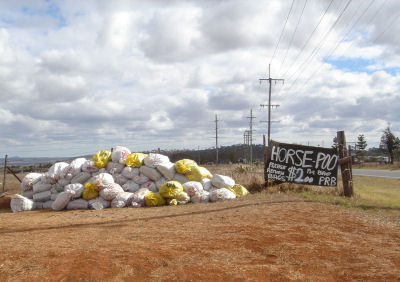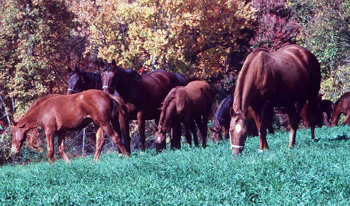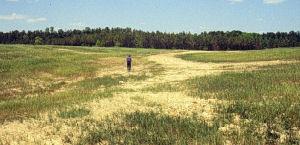Why Should You Have a Manure Storage Structure?
The capability to store manure reduces or eliminates the need to spread manure on a daily basis. The primary reason to store manure is to allow for land applicaitons that are compatible with the climate and cropping systems on the land receiving the manure. Saturated, wet, frozen, or snow-covered soil conditions are not suitable for land application of manure. The nutrients in horse manure are best utilized by the crop when spread before or during the growing season of the crop.
Many horse farms do not have extensive fields on which to spread manure. Manure storage facilities also allow the farm owner to store the manure until it can be removed and used by other farmers or landscapers.
Where Should You Locate a Manure Storage Structure?
Manure associated with horse production includes stall litter (feces, urine, bedding) and manure collected from exercise lots. Manure storage areas may simply be well-drained areas where the material is stacked or stockpiled for subsequent spreading operations. Manure should be stored in areas accessible to trucks, tractors, and other manure removal equipment.
Manure storage areas should not be located near waterways or wetlands. Rainfall or floodwater could carry manure into these water bodies. A well-drained manure storage area will prevent the pooling of polluted runoff that could serve as a breeding area for mosquitoes and flies. Manure should not be stored in paddocks or exercise lots, since lots can become infected with parasites. The presence of trees around the facility will help to dissipate odors and keep storage out of sight.
If no well-drained, level areas exist for manure storage, or if run-off presents a water quality issue, permanent manure storage facilities may be required as described in the NRCS Field Office Technical Guide. Permanent manure storage facilities should have an impervious bottom, and may have solid walls to confine the solids and a “push” wall for stacking and loading of the solids. Contaminated runoff or leachate from manure storage facilities must be managed as described in the NRCS Field Office Technical Guide.
Composting Horse Manure
Composting is a recommended management practice for horse manure management and, when done properly, will result in the destruction of internal parasites and weed seeds. The composted product can then be spread on pastures. Composting is a managed process, resulting in accelerated decomposition of organic materials. Microorganisms, including bacteria, actinomycetes, and fungi break down the organic materials at elevated temperatures.
Composting requires proper levels of moisture and oxygen, and the appropriate feedstock mixture to ensure proper microbial activity. Turning the composting material, aeration, ensures that all parts of the manure pile reach elevated temperatures for certain time periods. Compost will be less odorous than fresh horse manure and may have value as a soil amendment or fertilizer. For more information, see Composting Livestock or Poultry Manure.
Siting a compost area should address similar issues as discussed in the Where Should You Locate a Manure Storage Structure? section.
Minimum distances between manure storage/composting areas and other activities
| Sensitive Area |
Minimum Separation Distance (Feet) |
| Property line |
50-100 |
| Residence or place of business |
200-500 |
| Private well or other potable water source |
100-200 |
| Wetlands or surface (streams, pond, lakes) |
100-200 |
| Subsurface drainage pipe |
25 |
| Water table (seasonal high) |
2-5 |
| Bedrock |
2-5 |
(Adapted from On-Farm Composting Handbook, NRAES 54, 1992)
Please check on local standards as local manure storage areas and facilities should be sited based on existing regulatory standards.
Sizing of Manure Storage Facilities
The size of the manure storage area is dictated by manure removal practices and number of horses specific to that farm. If the manure is spread on crops on the farm, the storage area should be large enough to hold manure when fields are inaccessible. If manure is removed for off-farm use, the size of the manure storage area will be determined by the storage space requirements between removal periods. The NRCS Field Office Technical Guide should be consulted for more specific information about sizing storage facilities.
Management of Stored Manure
When properly managed, flies, odors, dust, and particulate matter can be controlled. Manure should be kept as dry as possible, since wet manure provides a breeding ground for flies and will lead to the presence of fly maggots. A roofed storage area may be advisable to keep manure as dry as possible when stored for long periods of time. It is possible to reduce fly larvae using predatory wasps and other parasites for control. It is important to avoid overusing pesticides to control flies.
Additional Information About Manure Storage
For more information please see:
Author: Michael Westendorf, Rutgers, The State University of New Jersey




